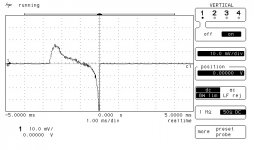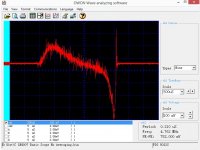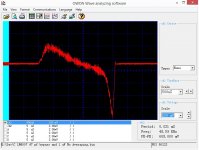OK as the author of THIS ARTICLE in Linear Audio magazine, I've gotten quite a few emails, private messages, and postal letters which all ask the same question:
Does your article talk about diode "X" ? I think diode "X" is really REALLY good, do you agree? Why on earth would anybody pick a diode other than diode "X" ?
It's not simply a one-off anomaly. It's not just a fad. It's a TREND. So here is my answer to all of you.
(1) If you haven't read the original article, maybe it would be useful and illuminating. Maybe it answers all of your questions, neatly and concisely.
(2) If you HAVE read that article, please be kind enough to say so. Say "Among the 48 diodes in your test, diode ZZZZZ seems the most similar to the one I care about, is there a significant difference between ZZZZZ and My Diode?
Does your article talk about diode "X" ? I think diode "X" is really REALLY good, do you agree? Why on earth would anybody pick a diode other than diode "X" ?
It's not simply a one-off anomaly. It's not just a fad. It's a TREND. So here is my answer to all of you.
(1) If you haven't read the original article, maybe it would be useful and illuminating. Maybe it answers all of your questions, neatly and concisely.
(2) If you HAVE read that article, please be kind enough to say so. Say "Among the 48 diodes in your test, diode ZZZZZ seems the most similar to the one I care about, is there a significant difference between ZZZZZ and My Diode?
Here is only one among MANY Private Messages that pop up in my Inbox whether I like it or not
(1) If you haven't read the original article, maybe it would be useful and illuminating. Maybe it answers all of your questions, neatly and concisely.
(2) If you HAVE read that article, please be kind enough to say so. Say "Among the 48 diodes in your test, diode ZZZZZ seems the most similar to the one I care about, is there a significant difference between ZZZZZ and My Diode?
Hi i have heard that You testet lots of recifier diodies for audio. Have you tested LT4320 mosfet controler? maybit it will be idal bridge controler for audio use, for very sensitive DAC's .Im thing to use this controler in salas 1.1bib power suply for soekris dam DAC. Thanks for any adwice!
(1) If you haven't read the original article, maybe it would be useful and illuminating. Maybe it answers all of your questions, neatly and concisely.
(2) If you HAVE read that article, please be kind enough to say so. Say "Among the 48 diodes in your test, diode ZZZZZ seems the most similar to the one I care about, is there a significant difference between ZZZZZ and My Diode?
I won't be reading it, since it will cost 3.49euro.
Being both Scottish and able to pick diodes I am not surprised
I should also add that, despite some disagreements with Mark in the past he has designed a simple snubbing rig to let you deal with the ringing that the diode can cause. Whether this HF ringing is audible or not is another discussion, but he is right in saying that people should not spam him with diode questions if the answers are given in a cheap article.
I won't be reading it, since it will cost 3.49euro.
OMG, that will take you to starvation! Why can't writers and publishers work for free? It's only fair!
smh
Eleven databooks, maybe. I pulled out the "mfr" column of the master table and counted eleven different manufacturers of the tested diodes. Yes, as intuition predicts, "Diodes Inc" is among them. List is attached below.A good data book and knowledge of the type of diode one needs is more than enough information.
Attachments
I won't be reading it, since it will cost 3.49euro.
No. It's only € 0.99 ;-)
Linear Audio | your tech audio resource
Jan
Doing a quick scan down the table, I count twelve Schottky diodes. The number increases, if you decide to include Silicon Carbide Schottky diodes in the count.... why they didn't compare them to Schottkies?
From the abstract: " ... 48 semiconductor diodes. They all rang, including Schottkys and HEXFREDs"
Mark,
Normally when I get specific questions, they get answered. No issue telling folks that their specific resistor, capacitor etc. was tested or not. Yes I know folks want single figure of merit answers to questions they don't fully understand.
However I think there is a lot more in your article than just what test results you got for any given diode.
Schottky diodes have a different mechanism and should exhibit no charge carrier depletion region at the junction, thus maximum turn off spikes of 30 nS or less. Yes there is transformer secondary ringing from even those diodes. As mentioned to you before my OPINION is that there is also turn on ringing. I think that contributes to the measured transformer ringing.
My recent best diode switching waveform is attached. I believe it shows turn on, turn on ringing first 1/2 cycle, noise passed from the power line during conduction time, decreasing current draw as charging progresses, a bit oof the rise in voltage as the transformer unloads from the peak current draw and then the turn off spike.
The power supply was as I recall a 24 volt toroidal transformer feeding a bridge of 1N4007s into a load of 470 ohms & 500 uF. the current probe was custom made and fed the 50 ohm oscilloscope input.
So for folks who want to start, they should be able to spend a Euro on your article as my bit on this should go for quite a bit more.
However I must let at least the cat's meow out of the bag. 1N400x are cheap but have a lot of noise...
Normally when I get specific questions, they get answered. No issue telling folks that their specific resistor, capacitor etc. was tested or not. Yes I know folks want single figure of merit answers to questions they don't fully understand.
However I think there is a lot more in your article than just what test results you got for any given diode.
Schottky diodes have a different mechanism and should exhibit no charge carrier depletion region at the junction, thus maximum turn off spikes of 30 nS or less. Yes there is transformer secondary ringing from even those diodes. As mentioned to you before my OPINION is that there is also turn on ringing. I think that contributes to the measured transformer ringing.
My recent best diode switching waveform is attached. I believe it shows turn on, turn on ringing first 1/2 cycle, noise passed from the power line during conduction time, decreasing current draw as charging progresses, a bit oof the rise in voltage as the transformer unloads from the peak current draw and then the turn off spike.
The power supply was as I recall a 24 volt toroidal transformer feeding a bridge of 1N4007s into a load of 470 ohms & 500 uF. the current probe was custom made and fed the 50 ohm oscilloscope input.
So for folks who want to start, they should be able to spend a Euro on your article as my bit on this should go for quite a bit more.
However I must let at least the cat's meow out of the bag. 1N400x are cheap but have a lot of noise...
Attachments
Thanks for your post, Ed! Your current probe must have been mighty sensitive to deliver 15mV into 50 ohms on a current peak of (I'm guessing) 0.6 amps. I note that your current waveform above is a member of a family of waveforms; it is the (zeta=0) member. I had fun in the LA article, plotting both the (zeta=0) and (zeta=1.5) family members on the same graph.
I hope the Editor won't mind if I let the cat out of the bag a teeny bit further, and say that the 1N4005 finished in 42nd place out of 48 diodes; 88% of diodes tested were superior. Furthermore, the 1N4005 was the very worst of the 1-amp-rated diodes; the diodes that stunk even more, were all rated for >1 amp.However I must let at least the cat's meow out of the bag. 1N400x are cheap but have a lot of noise...
Are there bulk discounts on the full mags?
I bought it, and several others in the past. In no way do I feel it was money not well spent, but universally I think a bit better testing could be done. My first hand experience has made preferances for diodes that weren't the highest scoring ones. ( although they didn't score very poorly)
I bought it, and several others in the past. In no way do I feel it was money not well spent, but universally I think a bit better testing could be done. My first hand experience has made preferances for diodes that weren't the highest scoring ones. ( although they didn't score very poorly)
Thanks for your post, Ed! Your current probe must have been mighty sensitive to deliver 15mV into 50 ohms on a current peak of (I'm guessing) 0.6 amps. I note that your current waveform above is a member of a family of waveforms; it is the (zeta=0) member. I had fun in the LA article, plotting both the (zeta=0) and (zeta=1.5) family members on the same graph.
I hope the Editor won't mind if I let the cat out of the bag a teeny bit further, and say that the 1N4005 finished in 42nd place out of 48 diodes; 88% of diodes tested were superior. Furthermore, the 1N4005 was the very worst of the 1-amp-rated diodes; the diodes that stunk even more, were all rated for >1 amp.
Now we got to quarrel! You just have to put in too much math references..
If the diode was 42nd place then there were 41 better diodes and 41/48 is only 85% of the diodes. (Note the significant digit bit..)
Never really calibrated the probes as all I wanted was a picture!
Attached are some older pictures showing the results of placing a snubber on the transformer secondary. Drops the line noise a bit and really cleans up the switch off inductive spike.
Attachments
It looks like the current probe is being subjected to a DC current in that test setup.
As a reference, would you be able to show the probe measuring a somewhat similar DC current waveform from say a DC supply with resistor load that is electronically switched, and hence give a typical square current waveform of similar 'current x time' duty cycle ?
As a reference, would you be able to show the probe measuring a somewhat similar DC current waveform from say a DC supply with resistor load that is electronically switched, and hence give a typical square current waveform of similar 'current x time' duty cycle ?
- Status
- This old topic is closed. If you want to reopen this topic, contact a moderator using the "Report Post" button.
- Home
- Amplifiers
- Power Supplies
- I heard about the Linear Audio article on Soft Recovery diodes, and ...




